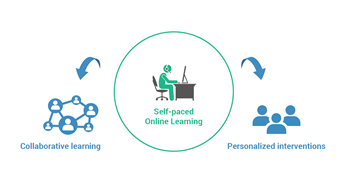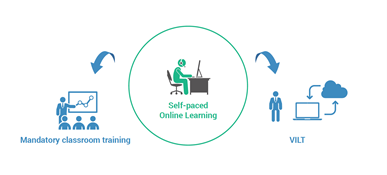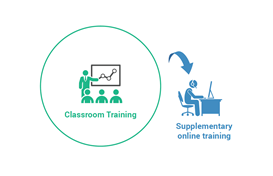5 Tips to Choose the Right Blended Learning Model for Your Business

As a training manager, you are well aware of the benefits of face-to-face training and the flexibility offered by online learning. And if you want to get the best of both these training methods to enhance your employee training, then blended learning is the way to go! But, it isn’t a ready-made instant solution, and demands you to consider a few things before you get started.
5 Questions to Ask Yourself before Choosing Your Blended Learning Model
- What are your training needs?
- What is the audience demographic?
- How are you going to schedule your training?
- How complex is the content?
- What are the resources available?
There is a variety of blended learning models to choose from and combine in the right proportion to address your training needs. According to the Christensen Institute, there are 4 primary blended learning models.
1. Rotational model (Flipped Classroom)

2. Flex model

3. Enriched Virtual model

4. À La Carte Model

Each of these models has different applications and can be used in various combinations, since no single model works as a standalone fix for all training needs. You’re probably wondering about what combination of blended learning models would be right for your training needs. Read on to find 5 tips to help you select the right blended learning model, so you can brew the perfect training cocktail.
Learn how beat the forgetting curve with blended learning in under 60 minutes!
5 Things to Do Before Selecting the Your Blended Learning Model
1. Identify Your Training Needs
An important first step is to conduct a training needs analysis (TNA) to identify gaps in your employees’ knowledge, skills, or attitudes and determine the training needs. Once you have identified them, you can pick the most relevant models which will help fill those gaps.
Example
The requirement from a global healthcare giant was to create flexible learning for a group of employees on a document management system. We recommended a blended learning model based on the Flipped Classroom and Flex models.
The training program began with an eLearning course to get learners familiar with the relevant concepts. After that, learners were given the option to continue the training sessions via eLearning or the classroom, depending on their convenience.
The training program was very well received due to the flexibility offered, which led to a 100% completion rate — a generally impossible feat for many training programs.
2. Analyze Your Audience
After identifying your training needs, you can start analyzing your audience, which is another determining factor when choosing a blended learning model. Organizations having a global presence with offices across different geographical locations will find it nearly impossible to organize classroom training for all employees at the same time.
Even if they were to conduct classroom training programs at each location, it wouldn’t be economically and logistically feasible to hold such training programs frequently. So, how do you deal with such a situation? By going for a blended learning model that is primarily online. The Flex Blended Learning Model would be the ideal choice here.
In case it is mandatory to include a classroom training component in the program, you can go for the Enriched Virtual Blended Learning Model where learning is mostly online with a small classroom component included.
3. Decide on the Training Schedule
How do you prefer your blended learning program? Should it:
- Follow a rigid fixed schedule?
- Allow personalized training?
- Facilitate collaborative activities?
Once you answer these questions, you can decide on the right blended learning model for your training needs. In case you are new to online learning and are more familiar with classroom training, you can choose to go with the À La Carte Blended Learning Model.
This model is primarily classroom-based, supplemented by online training. In case you require a fixed training schedule, the Rotational Model would work well as it offers greater control over the various learning components while ensuring timely completion.
The Flex Model is a good choice if there is an online learning component included in your training framework and you are looking to include collaborative activities and personalized interventions.
4. Consider the Complexity of the Content
Once you decide on the training schedule, it is time to consider the complexity of the subject or topic, before picking your blended learning model. Only online training may not be enough for more complex topics, and some classroom training may have to be included.
For complex content requiring hands-on practice, the Rotational Blended Learning Model is an ideal choice. In case of highly technical content, you might want to go for collaborative learning with personalized interventions where learners can interact with experts on discussion platforms or chats. For this, the Flex Blended Learning Model should be considered.
Apart from content complexity, you need to consider the technical infrastructure of your organization. For example, if your organization lacks a learning platform that supports a collaborative experience, then it would be impractical to implement a Flex Model.
In such cases, it is recommended to opt for the À La Carte Model which uses classroom training as its main component and online training to supplement it.
5. List all Relevant Resources
It’s now time to decide the blend. But before that, you need to make a list of all available human resources in your organization. Apart from instructors, you need to include facilitators who can act as guides to facilitate learning, and also SMEs to participate in expert discussions.
You might also have instructors involved in virtual instructor-led training sessions. The more resources available, the easier it is to implement a blended learning solution with more human touch points, like the Flex Model or the À La Carte Model.
In cases where there are few instructors available, it makes sense to invest in a blended learning model where learning is primarily online, like the Enriched Virtual Model.
After listing down the human touch points, you need to list down the online training components you’d like to use. There are numerous options in online learning with many microlearning assets to choose from, giving you the flexibility to go for full-fledged eLearning, microlearning, or learning podcasts.
To Sum it All Up!
Blended learning is the perfect choice for organizations looking to combine the benefits of classroom training and online learning to enhance the effectiveness of their training initiatives. Before selecting the blended learning model that is just right for your organization from the several models available, you need to consider your employees’ training needs, the audience demographic, scheduling choices, and the resources you have at your disposal for the training. Only then can you create the perfect blend that enhances performance and improves training ROI!




![Blended Learning Models: When to Use What [Infographic]](https://blog.commlabindia.com/hubfs/Imported_Blog_Media/blended-learning-models-choose-right-fit.png)
![6 Factors that Impact your Choice of Blended Learning Model [Infographic]](https://blog.commlabindia.com/hubfs/Imported_Blog_Media/blended-learning-model-influencing-factors.jpg)